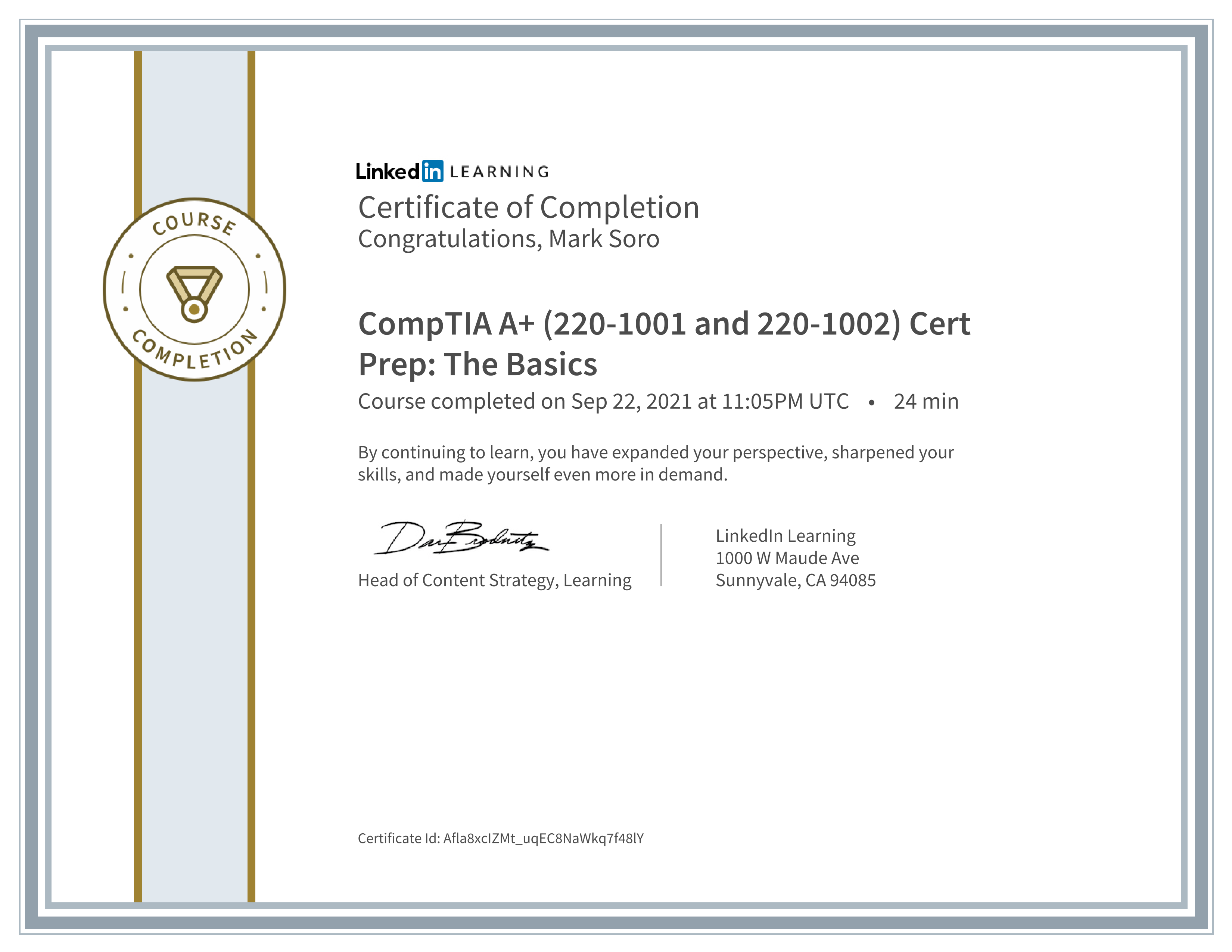
Chapter1: Safety and Professionalism - Objective 4.7
Professional Communication
Do’s: Be on Time, actively listening, clarify customer statements, maintain positive attitude/project confidence, avoid jargon and use plain language, set and meet expectation and communicate status
Dont’s: be culturally sensitive, use professional titles, avoid distractions, avoid being judgemental, avoid dismissing customers, deal appropriately with sensitive materials, don’t argue or be defensive, follow up with customer to verify satisfaction, provide proper documentation of services received, offer different service.
Phsyical Safety - Objective 4.4
EMP - Electro Magnetic Pulse, transfer of electro magnetic energy from one source to another that causes damage Safety goggles and air filter mask
Three types of EMP:
- Electrostatic discharge (ESD) - it can destroy components
- Electromagnetic Interference (EMI) - an electric motor next to network cables, can cause problems with the transmission, a big magnetic field can wipe off hard drives
- Radio Frequency Interference (RFI) - prevents transmissions, or slow down transmission
Prevent shock to sensitive components using:
- Use antistatic bag
- Disconnect computer before working
- Use Antistatic/ESD mat
- Anti static wrist strap
Tools of the trade - Objective 2.8
Given a scenario Use appropriate tools
Mike has a phone and number 2 phillips screwdriver
Quick Review
- PC repair toolkits are available
- Mobile toolkits
- Volt-ohm meter to test input voltage
- Always carry thumb drives
Troubleshooting theory - Objective 5.1
Given a scenario, use the best practice methodology to resolve problems
Always condider corporate policies, procedures, impacts before implementing changes
- Step 1: Identify the problem, Inquire regarding enviornmental or infrastructure changes, review system and application logs
- Step 2: Establish a theory of probable cause(question the obvious)
- Step 3: Test the theory to determine the cause, if theory is not confirmed, try another theory, escalate the issue
- Step 4: Establish a plan of action to resolve the problem and implement the solution
- Step 5: Verify full system functionality and if applicable, implement preventative measures, but it could be documentation, new company policy, escalation, can be casual or formal
- Step 6: Document findings, actions and outcomes
Comptia loves troubleshooting theory need to understand all the steps and the order of them
Chapter2: The visible computer - Objective 3.6
Explain the purposes and uses of various peripheral types
Quick Review
- System Unit - Contains the motherboard, CPU, RAM and hard drives; everything other device is a preripheral
- Monitors and web cameras provide visual output
- Keyboards, mice and game controllers provide input
- Printers create paper output
- Speakers and headsets make audio output
External Connections - Objective 3.2
Identify common connector types
Primary PC Components and External Connection
- Universal Serial Bus(USB)
- Network Cable Connection - using the cable RJ45 use for wired network (looks like telephone jack)
- Digital Visual Interface(DVI)
- Display Port
- HDMI(High Definition Multimedia Interface)
Older Ports
- mini-DIN(PS/2) - keyboards and mice, use by gamers(faster response)(color:blue and green)
- parallel port (LPT Port) - oldest connector known in PC, used almost exclusively for printers
- serial connector - the oldest connector in PC, original IBM PC in 1979
- Video Graphics Array(VGA) - used by monitors
Its important to know the names and basic functionality and shapes
Quick Review
- Make sure you can recognize all the rear desktop connections, including USB, network, power, video and audio
- Be familiar with common front desktop connections
- Make sure you can identify common connections on laptops
Inside the PC - Objective 3.5
Given a scenario, install and configure motherboards, CPUs and add-on cards
The montherboard is the primary device where we connect all the innards of the system unit together, RAM, CPU, hard drive
Quick Review
- Recognize the position and shape of power supplies and video cards
- Be familiar with the parts of the motherboard
- Make sure you can recognize the function core components: RAM sticks, CPU, M.2 SSDs, and hard drives
- Understand the function of expansion slots
What is a Computer? - Objective 3.5
Given a scenario, install and configure motherboards, CPUs, and add-on cards
Quick Review
- A computer gets work or play done
- A computer has a CPU, RAM, mass storage and an operating system
- Laptops, mobile devices, and Internet of Things(IoT) devices are all computers
What is an operating system? - Objective 1.1
Compare and contrast common operating system types and their purposes
Kernal - built in to operating system is the core part of the OS which handles the memory management
-
When a program starts to run its a ‘process’
- Operating Systems deals with Hardware using device drivers
- Storage - files and folders
- Networking
Quick Review
- An operating system controls all the programs on a computer
- The core of an operating system is the kernel
- Running programs are called processes
- Operating systems use device drivers to talk to hardware